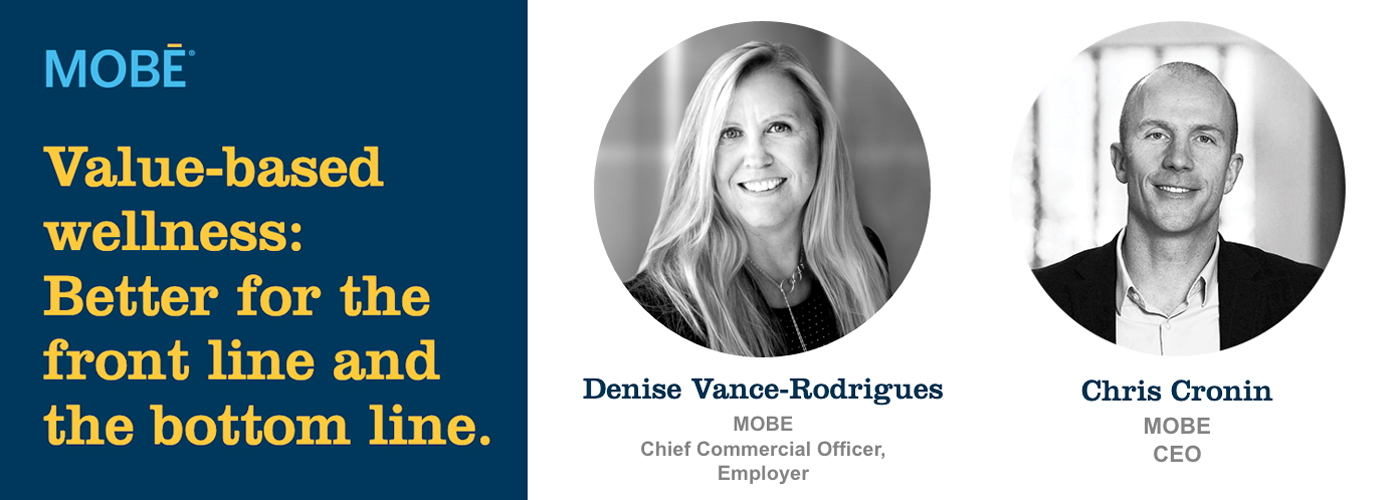
When it comes to your health and wellness, a recent New York Times article put it best: “Health happens in the 99.9 percent of your life when you’re not in the doctor’s office.”
Mental and physical health is especially important in times of transitionーand America’s workforce is on the precipice of massive change. Employers are reimagining work models and environments in response to the global pandemic, while also balancing employees’ health needs. MOBE’s recent 2021 Workplace Wellness Action Index tells us that 53% of employers will increase investment in health and wellness benefits overall in 2022ーbut supporting those employees on their path to happier, healthier living can’t be accomplished with a one-size-fits-all solution.
In early August, I joined a webinar with MOBE’s CEO, Chris Cronin. In our discussion, we dug into an important concept that is central to MOBE’s mission: value-based wellness. It’s a much-needed evolutionary change that expands on the concept of value-based healthcare, introduced in 2006 and continuing to gain momentum, which focuses on improving patient health and outcomes.
So, what is value-based wellness? Simply put, the idea that MOBE, as a wellness vendor, makes money only when we successfully improve the health of a population and save the employer money on their healthcare costs as a result.
The “secret sauce” to establishing a successful value-based wellness model consists of three steps:
Achieving this in practice requires a shift in approach for many employers. Employers are looking for healthcare data to support their investment in health and wellness solutions. However, our recent index revealed that many employers don’t have access to this data or the ability to analyze complex medical and Rx claims data. So, the majority (59%) fall back on employee anecdotes to support investment—and as a result, there is a very real skepticism around the ROI those investments are driving.
In order to make a true impact on both employee health and maintain a healthy bottom line, employers need a crystal ballーnot a rear-view mirror.
Employers must be able to understand how employee health needs will shift in the year aheadーseeing beyond today (or yesterday, as with insurance claims data), to predict future benefits needs. From there, employers must effectively engage those individuals to ensure that they’re connected with the right support at the right time. In fact, employees told us that the number one way employers can improve health and wellness offerings is to provide better communication about those offerings. With the disruption in the healthcare industry many point solutions have launched but multiple offerings and lack of coordination create confusion.
After the past year, knowing what the “right support” and “right engagement strategy” means for employees can feel like a complex moving target. But, employers should focus on the basics first and foremostーin fact, that’s where their investment is most effective. Data tells us that employees need wellness support that focuses on the foundation of their overall health: exercise, nutrition, sleep, and maintaining a healthy weight. In our 2020 and 2021 indexes, those four areas were consistently reported by employees as areas they most wanted to make a change but were continuing to face difficulties.
Advancements in data science and technology have made it possible to identify employees that need support the most in these areas of high impactーand, from there, provide personalized support and communication to those employees in order to help them make progress on their path to better health. MOBE was created out of the need for a solution that does exactly this, without creating additional costs for employers, employees, or the healthcare system. Our business model hinges on improved population health.
As employers continue to prioritize employee wellness in the year ahead, it’s critical that they focus on models that make a true impact without generating additional costs. To achieve that reality, value-based wellness must become central to their planning efforts. After all, employee healthーand employers’ bottom lineーdepends on it.
To learn more about value-based wellness and watch the webinar on-demand, click here.